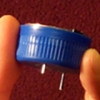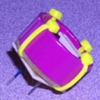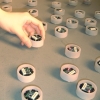Motivation
Dense sensing and actuation of the physical world requires the coordination and processing of a large amount of data. We believe any scalable solution must incorporate processing and data sharing at the level of the sensors and actuators themselves. Biological systems, such as skin and retina, evolved such abilities over long periods of time -- we must engineer these abilities into the systems we build, at first using system-specific heuristics but eventually forming a more general theory. Pushpin Computing is a first attempt at realizing such a system. It was inspired in large part by Bill Butera's Paintable Computing simulation work and the programming model presented therein.
System Overview
Pushpin Computing is a hardware and software platform primarily used for experimenting with and prototyping algorithms for distributed sensor networks. The platform currently consists of approximately 100 nodes inhabiting a 1.25m x 1.25m substrate.
People
The Pushpin Computing project was started and is currently headed by the Responsive Environments Group at the MIT Media Lab. The project currently includes:
- Faculty: Joe Paradiso
- Graduate Students: Josh Lifton and Michael Broxton
- Undergraduate Students: Daniel Benitez, Dan Taub, Yun Wu
Additionally, both Bill Butera and Deva Seetharam influenced the ideas used and directions taken by this project.
Recent Updates
|

|

|

|

|

|

|

|

|